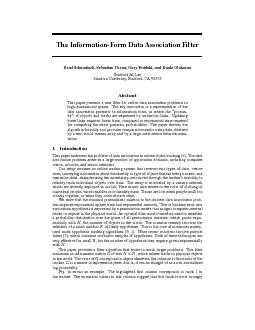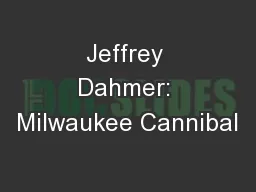PPT-Jeffrey D. Ullmam Stanford University
Author : danika-pritchard | Published Date : 2019-03-15
Mining Data Streams The Stream Model Sliding Windows Counting 1s 2 Data Management Vs Stream Management In a DBMS input is under the control of the programming
Presentation Embed Code
Download Presentation
Download Presentation The PPT/PDF document "Jeffrey D. Ullmam Stanford University" is the property of its rightful owner. Permission is granted to download and print the materials on this website for personal, non-commercial use only, and to display it on your personal computer provided you do not modify the materials and that you retain all copyright notices contained in the materials. By downloading content from our website, you accept the terms of this agreement.
Jeffrey D. Ullmam Stanford University: Transcript
Download Rules Of Document
"Jeffrey D. Ullmam Stanford University"The content belongs to its owner. You may download and print it for personal use, without modification, and keep all copyright notices. By downloading, you agree to these terms.
Related Documents





![http://cs173.stanford.edu [BejeranoWinter12/13]](https://thumbs.docslides.com/166170/http-cs173-stanford-edu-bejeranowinter12-13-578.jpg)
![http://cs173.stanford.edu [BejeranoWinter12/13]](https://thumbs.docslides.com/445066/http-cs173-stanford-edu-bejeranowinter12-13.jpg)
![http://cs273a.stanford.edu [BejeranoFall13/14]](https://thumbs.docslides.com/536015/http-cs273a-stanford-edu-bejeranofall13-14-.jpg)
![http://cs273a.stanford.edu [BejeranoFall14/15]](https://thumbs.docslides.com/538561/http-cs273a-stanford-edu-bejeranofall14-15.jpg)
![http://cs273a.stanford.edu [Bejerano Fall16/17]](https://thumbs.docslides.com/540020/http-cs273a-stanford-edu-bejerano-fall16-17.jpg)
![http://cs273a.stanford.edu [BejeranoFall14/15]](https://thumbs.docslides.com/540407/http-cs273a-stanford-edu-bejeranofall14-15-.jpg)
![http://cs273a.stanford.edu [Bejerano Fall16/17]](https://thumbs.docslides.com/540408/http-cs273a-stanford-edu-bejerano-fall16-17-.jpg)


